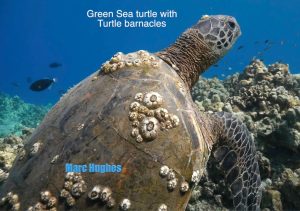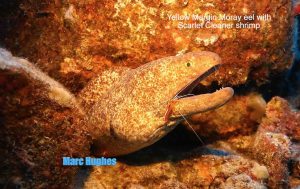 |
| Thursday Night at the Center presents Marc Hughes and his marine life videography on May 11 from 6 p.m. to 7:30 p.m, at Volcano Art Center Niualani Campus. See more below. Photo by Marc Hughes |
GOV. JOSH GREEN: MAJOR DIRECTIONAL CHANGES FOR HAWAI'I. That's the message in the Governor's review of his first five months in office, saying, "In just under five months we are already initiating major directional changes for Hawai'i.
"Based on what was announced by legislative leaders about the budget earlier this week, signature positive results include rebuilding our public education system with a new contact that rewards those who become teachers, more than $60M for kauhale and 'Ohana Zones to address chronic homelessness, $30M in loan forgiveness to recruit and retain social workers, nurses and physicians for Hawai'i, a new housing package to accelerate the response to our housing crisis, millions to improve rural hospitals on the Big Island and more than $100M for statewide environmental programs and climate response.
"Generational tax reform to help ALICE, which refers to Asset Limited, Income Constrained, Employed families, has begun and the legislature approved about half of Green Affordability Plan (GAP Plan) in this
 |
| Gov. Josh Green says tax reform will help ALICE families. |
"We filled a Cabinet of 18 directors and more than 20 deputies, losing 3 nominees along the way where we didn't have a meeting of the minds with the Senate, but this wasn't altogether unexpected.
"Our team authorized $50M of grants-in-aid that had been neglected in 2022 and released more than $300M in capital funding for projects all across Hawai'i.
"We made major progress transferring lands to farmers and ranchers via Act 90 in a very short time and should see growth in agriculture quickly.
"Over the next eight months we will focus on building multiple kauhale, greenlighting affordable housing developments including $600M for the Department of Hawaiian Homelands. We will press the military to drain Red Hill safely and we will begin to implement our new tax policy to help people survive in Hawai'i.
"With the initial legislative rebuff of HTA we will need to refocus our approach to tourism to avoid major economic harm to Hawai'i. I have hopes that this will be resolved this weekend. Still, it is a good time to reinvent tourism in our state, with a focus on managing the impact of almost 10M visitors annually.
"Now that we have the final parameters on funding a new Aloha Stadium, we can launch the project and court a partner to build it.
"In all, this has been one of the most active periods for government in recent memory and we are grateful to be able to make change for the better in the coming months and years."
To read comments, add your own, and like this story, see facebook.com/kaucalendar. See latest print edition at kaucalendar.com, in the mail and on stands.n stands.
POLICE ARE SEARCHING FOR A RUNAWAY IN VOLCANO. Hawai‘i Island police are asking for the
Faamama was last seen on Friday, April 28 at 9 p.m. on 10th Street in Mauna Loa Estates in Volcano wearing maroon sweatshirt and gray sweatpants. Faamama is described as local with a dark complexion, approximately 5 feet 3 inches tall, 115 pounds, with black hair and brown eyes.
Police ask anyone with information about Faamama’s whereabouts to call 911 immediately.
MUTUALISM, PARASITISM, COMMENSALISM in the underwater world around Hawai'i Island are topics to be explored by Marc Hughes who presents his videography on Thursday, May 11 at 6 p.m. The venue is Volcano Art Center Niaulani Campus in Volcano Village.
The presentation provides a visual display of many associations that can be seen in scuba diving and snorkeling depths in the oceans around the Big Island. It encompasses a wide range of behavioral adaptations including symbiotic classifications such as mutualism, parasitism, and commensalism.
"The videos and accompanying explanations of the intricate nature of these interactions show just how complex the marine environment is and how important it is to preserve the coastal areas. Questions and discussions are welcome, and the goal of the presentation is to highlight the importance of individual species of animals as they relate to the overall health of the marine environment."
Hughes is a dive guide and marine life educator in Kailua-Kona, Hawaii. He graduated with a degree in Marine Science and Conservation Biology from the University of Hawaii in Hilo and participated in research cruises in the Northwestern Hawaiian Islands as well as cephalopods research cruise in the Main Hawaiian Islands. All the videos in the presentation have been taken by him and part of his program for teaching the public and students through visual examples with a storytelling point of view.
The presentation is part of a once-a-month Thursday night series at the Volcano Art Center, focusing on art, Hawaiian culture and this environment. The series is intended to inspire, enhance your appreciation of art and life experience, while fostering community connections. This presentation is free, although a $5 donation is greatly appreciated.
 |
Logo and motto of Hawaiian Volcano Research Association, a private source of financial support for HVO for several decades. Thomas Jaggar's vision became the USGS Hawaiian Volcano Observatory. |
When HVO was founded, Hawai'i was not yet a state. Hawaiʻi Volcanoes National Park did not yet exist. A lake of molten lava was on the floor of Halemaʻumaʻu similar to what we’ve seen over the past three years. HVO was originally operated with support from the Massachusetts Institute of Technology (MIT) and the Hawaiian Volcano Research Association, and later managed by a series of federal agencies including the U.S. Weather Bureau, the National Park Service, and the USGS.
The USGS became the permanent administrator of HVO in 1947. Based on HVO's success, the USGS went on to establish additional observatories to monitor and study 161 active volcanoes throughout the United States and U.S. Territories.
HVO focuses on the six active volcanoes in Hawaiʻi including two “very high threat” volcanoes—Kīlauea and Mauna Loa—and one “high threat volcano,” Hualālai. HVO also monitors active volcanoes in American Samoa.
Cascades Volcano Observatory (CVO) was authorized in 1980 following the eruption of Mount St.
Helens and formally dedicated in 1982. CVO focuses on volcanoes in Washington, Oregon and Idaho. CVO is also home to the USGS Volcano Disaster Assistance Program (VDAP) which aids crisis response at volcanoes around the world.
Alaska Volcano Observatory (AVO) was founded in 1988 following the 1986 eruption of Augustine Volcano. AVO, a collaboration between the USGS, the University of Alaska Fairbanks, and the State of Alaska, focuses on volcanoes in Alaska and the Commonwealth of Northern Mariana Islands.
Yellowstone Volcano Observatory (YVO) was founded in 2001. YVO, a consortium of nine state and federal agencies, focuses on volcanic activity in the Yellowstone Plateau region and intermountain west U.S. states.
California Volcano Observatory (CalVO) was formed in 2012. CalVO, with expanded scope beyond the Long Valley Observatory (LVO) established in 1982, focuses on volcanoes in California and Nevada. The collective knowledge, skills and experience of people at these five observatories is extensive and complementary. Staff communicate and travel between observatories in true team fashion. HVO staff help install instruments on volcanoes outside of Hawaii, and vice versa. The lead scientist for the Kīlauea Seismic Imaging Project described in a recent Volcano Watch article is based at CVO, and many scientists from other observatories are traveling to Hawai'i to assist. Staff from all observatories assisted HVO during the 2018 Kīlauea and 2022 Mauna Loa eruptions. HVO supported eruption responses at other volcanoes such as Mount St. Helens, and will help respond to future events at other volcanoes.
Fulfilling our mission involves constant evolution and holistic future planning. As an example of preparing for possible future scenarios, HVO is participating in a virtual “tabletop exercise” led by CVO to practice responding to simulated unrest at a volcano in Oregon. And at the national scale, we are collectively developing the National Volcano Warning System (NVEWS) to ensure that volcanoes are monitored at levels commensurate to their threats. HVO has grown and changed significantly over the past 111 years. Together with four other USGS volcano observatories established since that time, our mission continues—to assess hazards, issue warnings, and advance scientific understanding to reduce the impacts of volcanic eruptions. And to communicate the results of our work to the public, emergency managers, and the scientific community. Imua!
Webcams show no signs of active lava in Halemaʻumaʻu crater, at the summit of Kīlauea in Hawai‘i Volcanoes National Park. Over the past week, summit tiltmeters generally showed mild inflation and slightly elevated seismicity. The summit sulfur dioxide (SO2) emission rate was most recently measured on April 26, when it totaled 75 tonnes per day.
Mauna Loa is not erupting. Its USGS Volcano Alert Level is at NORMAL.
Webcams show no signs of activity on Mauna Loa. Seismicity remains low. Summit ground deformation rates show inflation above background levels, but this is not uncommon following eruptions. SO2 emission rates are at background levels.
There were eight earthquakes with 3 or more felt reports in the Hawaiian Islands during the past week: a M3 earthquake 14 km (8 mi) S of Fern Forest at 4 km (3 mi) depth on April 26 at 10:09 p.m. HST, a M3.9 earthquake 10 km (6 mi) NNE of Honaunau-Napo'opo'o at 26 km (16 mi) depth on April 26 at 7:27 p.m. HST, a M4.2 earthquake 12 km (7 mi) ESE of Pāhala at 29 km (18 mi) depth on April 26 at 4:30 p.m. HST, a M2.4 earthquake 3 km (1 mi) SE of Volcano at 1 km (0 mi) depth on April 23 at 2:59 p.m. HST, a M2.5 earthquake 2 km (1 mi) SSE of Volcano at 1 km (0 mi) depth on April 22 at 2:33 p.m. HST, a M4.1 earthquake 2 km (1 mi) SSE of Volcano at 1 km (0 mi) depth on April 22 at 2:23 p.m. HST, a M3.2 earthquake 3 km (1 mi) SSW of Pāhala at 34 km (21 mi) depth on April 21 at 10:17 p.m. HST, a M2.2 earthquake 2 km (1 mi) SSE of Volcano at 1 km (0 mi) depth on April 21 at 9:59 p.m. HST.








.jpeg)

.png)
.jpg)
.jpg)
